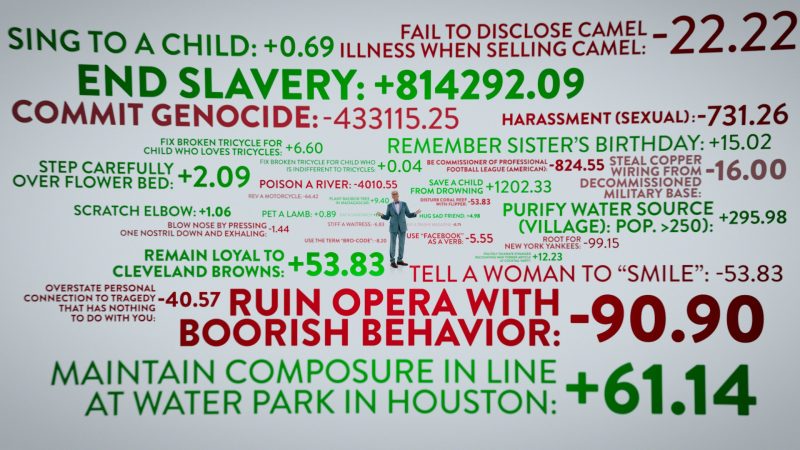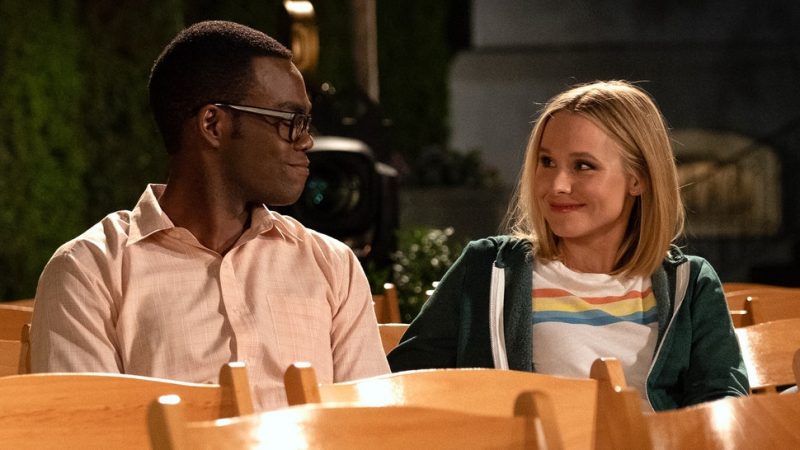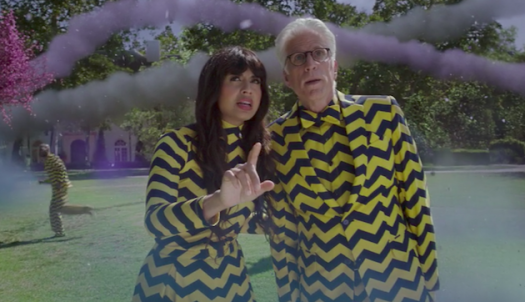Is “The Good Place” speculative design?
Posted on November 15, 2019A caveat
I am extremely new to speculative design and am still learning much about it. This post is a reflection of an initial reflection of how I’m processing speculative design. The following discussion includes questions I continue to hold as I learn more about the practice.
Defining speculative design
Speculative design, as defined by Anthony Dunne and Fiona Raby, is the practice of “speculating how things could be” [1]. It is a “form of design that thrives on imagination and aims to open up new perspectives on what are sometimes called wicked problems, to create spaces for discussion and debate about alternative ways of being, and to inspire and encourage people’s imaginations to flow freely,” often borrowing the kind of imagination used in science fiction and cinema [1].
A Good Place
When I was first introduced to speculative design a few weeks ago, I immediately thought of a current favorite television show of mine, “The Good Place,” to which I started to wonder: how is something like “The Good Place” different from speculative design? Is “The Good Place” just an extremely successful act of futuring that is actually speculative design in popular media?
If you aren’t familiar with the show, “The Good Place” speculates about an afterlife. It is explored through 4 different different people who find themselves in what they think is the “good place,” only to realize that in being forced together, their dynamic tortures one another, and that they are actually in “the bad place”. They end up in “the bad place” based on a calculation of actions they had taken while they are alive. Though “The Good Place” does have a fantastical plot, there’s something grounded and philosophical about the plot, tied together with humor that has caused me (and thousands of others!) to ask questions about the life we live.
In an effort to try to understand whether or not “The Good Place” is, in fact, speculative design in action, I will attempt to break down my current understanding of speculative design as a viewer of “The Good Place,” to see how it relates to speculative design. The components I currently see as key to how speculative design is defined: involvement in wicked problems, bringing about new debate about a topic, imagination and speculation based on an understanding of reality.
The Wicked Problem?
A wicked problem is defined as a problem that is “ill-defined; and they rely upon elusive political judgment for resolution…Social problems are never solved. At best they are only re-solved – over and over again.)” [2]. Rittel and Weber refer to “wicked problems” as they relate to topics of policy and planning – problems that can’t be solved with straightforward, standardized, or formulaic methods but heavily require an understanding of the problem itself before providing a solution [2].
“The Good Place” as a TV show does not address an explicit wicked problem, though it does touch on subjects that could be similarly complex. One underlying concept in “The Good Place” is the formula that determines where you end up in the afterlife: whether you end up in “the good place” or “the bad place.” This brings into question behaviors exerted during the time the humans were alive in the show, particularly when someone behaves in immoral, destructive or selfish ways during a lifetime. Though this inherently isn’t necessarily a wicked problem, the plot implicitly calls into question ethics that can be inferred, based on what we consider to be “ethical” behavior, given that individuals have varying moral and ethical perspectives: what is true, ethical behavior?
Discourse
“The Good Place” brings in new discourse by designing a narrative that takes on one perspective of what may happen in an afterlife, and may cause viewers to ponder what our afterlife might be: Do we believe in an afterlife? What positive and negative actions might we have taken that contribute to our overall values? What is ethical, and what isn’t ethical? What do we think about the actions others take and their values? For example, Chidi, who was a professor of ethics in his lifetime, is an extremely knowledgeable and kind individual, and aims to live his life ethically. However, because of his constant ethical dilemmas, he still finds himself “the bad place” because of all the pain his indecision has caused others in his lifetime.
The goal of speculative design is to intersect between the probable and plausible – not to predict the future but to use design as a method to open up possibilities that can be “discussed, debated, and used to collectively define a preferable future for a given group of people” [1]. “The Good Place” seems to do exactly this.
Imagination, based on reality
According to Dunne and Raby, “futures are not a destination or something to be strived for but a medium to aid imaginative thought—to speculate with.” [1]. “The Good Place” also uses an imaginative plot and humor to create a future world in the afterlife.
Dunne and Raby also note that speculating “should be scientifically possible, and “there should be a path from where we are today to where we are in the scenario” [1], meaning that speculative design cannot be pure fantasy. “The Good Life” does speculate based on real characteristics that individuals hold during their time alive, given that it is grounded in actions that are believable and feasible.
To conclude
While “The Good Place” certainly is based on imagination grounded in reality, brings up new discussion about the topic, and it does indirectly touch on a complex question, according to the original definition, “The Good Place” may be an example of speculative design.
However, a few questions still remain for me:
Dunne and Raby mention in Speculative Everything that they are interested in using speculative design to collectively define “a preferable future” for a certain group of people to “general futures that act as catalysts for public debate and discussion about the kinds of futures people really want” [1]. Given that the primary intent of “The Good Place” seems to be to entertain, even if it does provide an imaginative discourse, is it speculative design?
Additionally, what about the medium itself? Dunne and Raby specifically mention that speculative design should include “diversity in value and process [1]” and borrow from other mediums like science fiction and cinema and be vetted by other experts, but does the final outcome of speculative design need to be an object that lives in the world for people to interact with and react to? Speculative design is typically a series of physical objects, whereas “The Good Place” is a digital narrative. Design, as defined by Boehnert and Onafuwa, is the “reproduction of ideas, practices, products and tools” [3], meaning that by this definition, a television show would be “design.” Dunne and Raby, though, specifically place an emphasis specifically use of “products” in everyday life. So does that make “The Good Place” disqualified as speculative design? Or is the plot of “The Good Place” just tying together multiple examples of what might be speculative artifacts, in narrative? While I don’t think speculative design needs to be exclusively physical, it is also important to note that the “future” that “The Good Life” speculates on is a speculation of life after death, therefore not reflecting what a society could be in a future time. How essential is this juxtaposition with time in speculative design?
“The Good Place” also does not bring up a “preferable” future, nor does it address a wicked problem. Even though it is imaginative discourse that brings up ethical questions, and is grounded in reality, perhaps this means that “The Good Place” is just a successful speculation, though not speculative design. Perhaps “The Good Place,” is, in fact, not speculative design then, but a form of science fiction that speculative design could borrow from?
What makes speculative design, speculative design? Who makes these decisions? What medium does speculative design need to take? How important is the intent behind speculative design? Which direction does “future” need to be in? Can speculation take place after death as well? Is a narrative with multiple aspects of speculation still speculative design?
Even though by the original definition, “The Good Place” seems to be speculative design, I would hesitate to call it speculative design. However, it is important to note that what “The Good Place” brings to its viewers may accomplish a similar goal to that of speculative design.
As Dunne and Raby call for speculative design to cross-pollinate with other media, perhaps this is a call for further understanding what the intersection between speculative design and popular media might be – how can media like “The Good Place” borrow from thinking surrounding challenging how wicked problems are thought about? How can design borrow from narratives and the character development of television?
—
Some examples of speculation from “The Good Place, which brings into question ethics of the actions you may take during your life:
- The Formula: how the point system calculates which afterlife you end up in based on the actions you take during your time alive on earth [A]
- Soulmates: being matched with your “perfect” soulmate in the afterlife because the system knows how to optimize for companionship, since most people do not find soulmates on earth [B]
- Exclusive pajamas: Everyone in “the good place” showing up in matching pajamas except for Eleanor, in order to show her that she doesn’t belong [C]
- Machines: Machine that is created based on things you like (i.e., shrimp for Eleanor) in order to test your willpower. [D]

[A] A snapshot of the formula for actions of how people end up in the “Good Place” or “Bad Place”

[B] Soulmates: being matched with your “perfect” soulmate because the system knows how to optimize for companionship since most people do not find soulmates on earth

[C] Everyone in “the good place” showing up in matching pajamas except for Eleanor, in order to show her that she doesn’t belong

[D] Machine that is based on things you like (i.e., shrimp for Eleanor) in order to test your willpower.
Sources:
[1] Dunne, Anthony, and Fiona Raby. Speculative Everything: Design, Fiction, and Social Dreaming. London, England: MIT Press, 2013, 2.
[2] Rittel, Horst W. J., and Melvin W. Weber. Dilemmas in a General Theory of Planning. Vol. 4. No. 2. Springer, 1973.
[3]Boehnert, Joanna, and Dimeji Onafuwu. “Design as Symbolic Violence: Reproducing the ‘Ism’s A Framework for Allies.” Intersectional Perspectives on Design, Politics and Power, 14 Nov. 2016